A field plows a peaceful tractor, a reactor flies across the sky
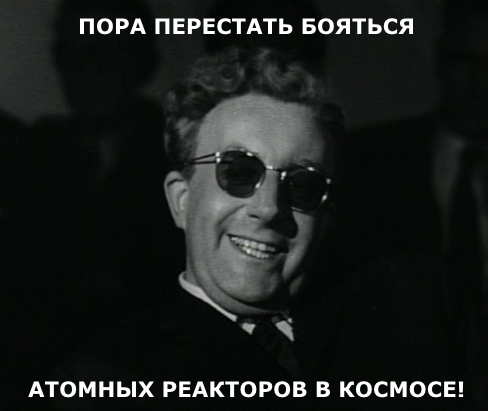
Unlike atomic explosions , which existed only in projects, and atomic engines , which reached the stage of ground tests, nuclear reactors were used in space for energy and flew quite massively, more than three dozen of them flew into space.
Theory
We begin, as always, with the theory. It would be great if the nuclear chain reaction produced electricity directly, which could be used immediately. But alas, the result of nuclear decay is heat, which has to somehow be converted into electricity. To do this, the heat from the reactor goes to heat engines (thermoelectric converters, thermionic converters, turbines, Stirling engines, etc.) that generate electricity, and then is discharged into the space from radiators-coolers. And the reactor takes on the characteristic shape of a badminton shuttlecock:

In space, every gram is worth its weight in gold, so the design of heat engines and radiators becomes as important as the design of the reactor. And the inevitable losses in the conversion of heat into electricity force us to speak of two parameters - thermal and electrical power. And electric power is several times less than thermal. In ground-based power reactors, which have no restrictions on mass and size, electrical power is 3-4 times less than thermal power; in space reactors, the situation is still much worse.
')
Comparison with solar panels
To ensure that the numbers of the parameters of cosmic nuclear reactors are not dead, let's compare them with the parameters of solar panels. The site of JSC "Saturn" has the parameters of solar panels:
- Silicon panels: 140 W / kg at the beginning of work and 80 W / kg after 15 years.
- Gallium arsenide panels: 196 W / kg at the beginning of work and 157 W / kg after 15 years.
Those. in order to get 1 megawatt of power, we need 7142 kg of silicon panels, or 5102 kg of gallium arsenide panels. But this is a “bottom” estimate, because the mass of farms, buildings and other things is not taken into account. To assess the "top" take the parameters of the solar panels MKS. MKS trusses with solar panels have a mass of 15,824 kg. Each design bears on itself two solar “wings”, giving 31 kilowatts at the beginning of work and 26 after 15 years each. Accordingly, one design will give us 60 kilowatts for a mass of 15 tons, and we will need 250 tons to produce a megawatt of energy. Of course, in the case of creating a specific engineering structure, this frightening value can be somewhat reduced, for example, by increasing the length of the panels, but in reality the solar installation, giving us 1 megawatt of energy, will be closer to 250 tons than to 5.
Story
USA
SNAP
In the United States, work with space power reactors was initially carried out as part of the SNAP program (Systems for Nuclear Auxiliary Power). In 1959, the experimental SER reactor was launched, which had a thermal capacity of approximately 50 kilowatts. The reactor was purely experimental, the heat just dissipated in the air. After working for two years, the reactor opened the way for the following models.
The second was the SNAP-2 reactor, which operated from 1961 to 1962. Having a thermal power of 55 kilowatts, the design made it possible to connect a heat engine with a power of 3.5 kW.
The next stage was two SNAP-8 reactors with a thermal capacity of 600 kW and 1 MW. The megawatt reactor had a 24x84 cm active zone, contained 8.2 kilograms of nuclear fuel, used mercury as a coolant, and could produce energy as a steam engine (using the Rankine cycle ).
The pinnacle of the program was the SNAP-10A reactor, which was launched into orbit on April 3, 1965:

The reactor had the following characteristics:
- Core dimensions: 39.6 x 22.4 cm.
- Mass without radiation protection: 290 kg.
- Thermal power: 30 kW.
- Maximum electric power achieved: 590 W.
- Type of heat engine: thermoelectric converter .
The reactor on an experimental satellite was supposed to power an electrojet engine. Unfortunately, on day 43 of the flight, an attempt to turn on the engine led to a malfunction of the voltage regulator and the emergency shutdown of the reactor. The satellite is still flying in polar orbit and will fall to Earth in ~ 4000 years. You can watch the video on the project (in English).
The SNAP project worked with radioisotope generators, but American nuclear reactors no longer flew into space.
SP-100
In 1983, the research program SP-100 was launched, the purpose of which was to develop a reactor with thermionic or thermoelectric converters and heat transfer using heat pipes :

Judging by the lack of information, the program has been closed.
SAFE
At the beginning of zero, there was a SAFE project (Safe Affordable Fission Engine - a safe engine available on fissile materials). The SAFE-400 reactor was supposed to have a heat output of 400 kW, an electric power of 100 kW, and use a gas turbine to generate electricity. On the Internet there is a photograph of the reactor SAFE-30 from 2001:

The sources indicate the year 2007 as the expiration date of the project, which implies its freezing or termination.
Los Alamos Project
In 2012, a very nice video appeared with a simple power reactor project from the Los Alamos laboratory:
The proposed reactor is very simple in construction, which makes it available for production, but it does not differ in record parameters. As an active zone, it is proposed to use a hollow cylinder of enriched uranium weighing 22.5 kg. The active zone is surrounded by a beryllium neutron reflector with a diameter of 25 cm. The height of the active zone is 30 cm. A single boron carbide rod is used to control the reactor. Heat from the reactor is removed heat pipes and is supplied to Stirling engines with a total power of 500 watts. Here is the reactor layout:

Unfortunately, this is only a presentation, and the future fate of the project is unknown.
USSR and Russia
"Chamomile"

The first domestic experimental nuclear space reactor was the "Chamomile". A reactor with a thermal power of 40 kW and electric 800 W used thermoelectric converters. The reactor was first launched in 1964. S.P. Korolev wanted to use "Chamomile" together with plasma ERE. But after the end of the Chamomile tests in the summer of 1966, after the death of Korolev, she did not fly into space.
"Beech"
But the second series of space reactors, the BES-5 Buk, has flown into space more than a dozen times. These reactors were used as a source of electricity for US-A radar reconnaissance satellites, known in the West as RORSAT:
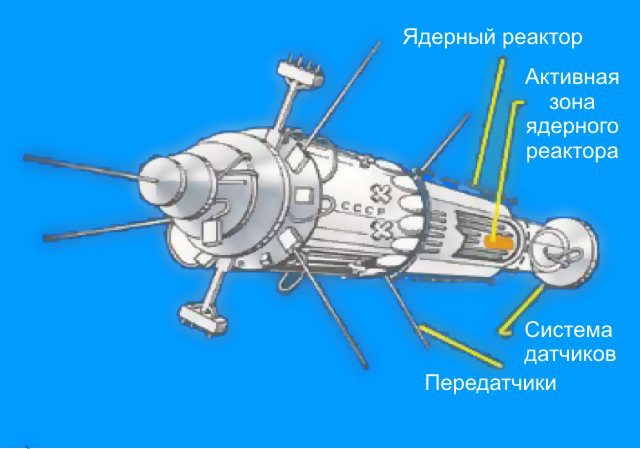
The radar required a lot of power and low orbit. A low orbit meant that the satellite would constantly fall into the shadow of the Earth. A set of solar batteries and batteries would be too heavy, and this made the nuclear power plant the only option. Reactor BES-5 had the following parameters:
- Thermal power: 100 kW.
- Electric power: 3 kW.
- Reactor weight: 900 kg.
- Type of heat engine: thermoelectric generator.
- The mass of nuclear fuel: 30 kg.
- Work term: ~ 135 days
A total of 35 launches were committed, of which in 33 launches the reactor was put into orbit. A special feature of the project was the safety measures - the reactor in the event of an accident or at the end of the work was put into a disposal orbit with a height of 750-1000 km and a life of ~ 250 years. In the event of a system failure, the reactor was supposed to burn and collapse upon entering the dense layers of the atmosphere. Unfortunately, the initial version of the destruction system was not very successful, it had to be finalized. US-A satellites were launched from 1970 to 1988 and were successfully used for radiolocation reconnaissance of maritime spaces, and in the event of the outbreak of hostilities, they could provide target designation for missile-carrying submarines, working as part of the Legend complex .
"Topaz"
The development of the Buk reactors was TEU-5 Topol, also known as Topaz-1:
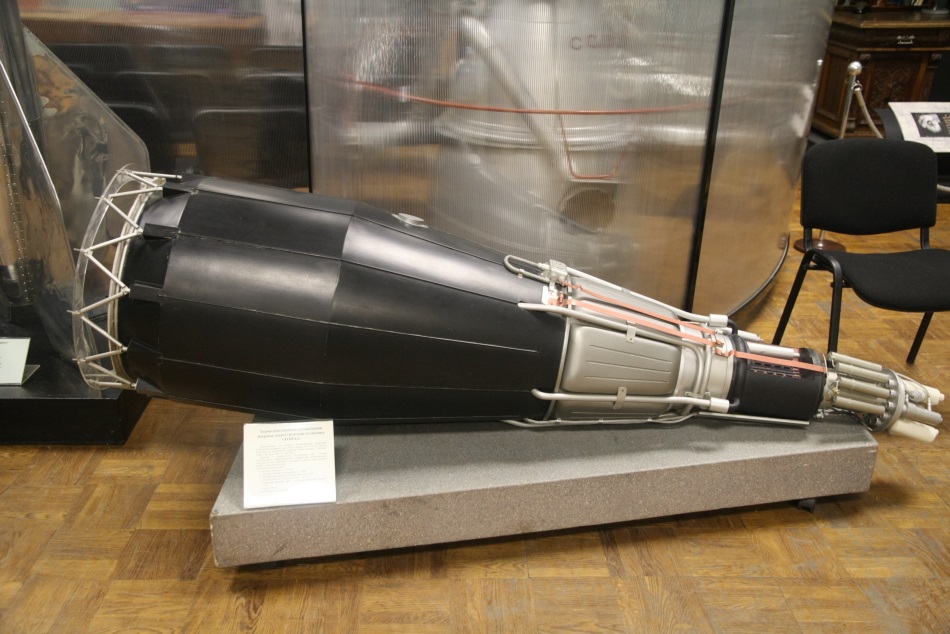
Topaz had improved parameters:
- Thermal power: 150 kW.
- Electric power: 5-6 kW
- Type of heat engine: thermionic generator .
- The mass of nuclear fuel: 11 kg.
- Work term: 1 year.
The reactor twice flew into space on the Kosmos-1818 and Kosmos-1867 satellites and was used for the same purposes — radar reconnaissance.
Yenisei
Reactors of the Yenisei type were proposed for civilian television broadcasting satellites. The peculiarity of the reactor was the replacement of classical fuel elements with electricity generating channels - the core was combined with a heat engine. The reactor was supposed to have a thermal power of 115-135 kW, an electrical 4.5-5.5 kW and a service life of three years. The project was closed in the early 90s, in 1992, the United States bought two reactors, but did not use them in space.
Transport and energy module RSC Energia
Since about 2010, an active development of the transport and energy module using a nuclear reactor and electric propulsion engines has been going on. Such a nuclear tug can carry cargo on the Earth-Moon route, and after working out the main resource, fly with the probe to other planets in the solar system. The project was shown at MAKS-2013 , there are regular news about the progress of work. The latest news - assembled the first fuel element . The characteristics of the power plant and the module as a whole are also quite impressive:

The power capacity of the reactor is 1 MW in combination with electric propulsion with a specific impulse of 7000 seconds and a 18 N (2 kg) load - this is a technological breakthrough.
Security questions
Speaking of nuclear energy, one can not fail to mention the well-known radiation accidents and measures to combat them.
In 1964 there was a destruction in the atmosphere of the American radioisotope generator SNAP-9A due to a launch vehicle crash at the launch site. Since RTGs use highly concentrated plutonium, which is scattered in the atmosphere, there was a significant increase in radiation background around the world. The lesson was learned, changes were made to the design, and when the Nimbus-B satellite crashed with RTG SNAP-19B2 in 1968, nuclear materials did not scatter in the atmosphere, but fell into the ocean and were subsequently lifted from the ocean floor without contamination. territory. In 1970, the RTG lunar module "Apollo-13" fell into the ocean and sank at a depth of 6000 meters without destroying and contaminating the terrain. In 1973, a Soviet satellite with the Buk reactor fell into the Pacific. There is no data on contamination of the area. In 1978, debris from the Kosmos-954 satellite fell on the territory of Canada. Due to the flaws in the emergency system, the reactor core was not sufficiently destroyed, and a minor contamination of the area occurred. However, a terrible scandal erupted, the USSR had to pay compensation to Canada for the costs incurred in searching for debris and decontamination of the terrain. After this event, the security system was improved, a gas generator was installed, guaranteed to destroy the core when entering the atmosphere. The fall of the Cosmos-1402 satellite to the South Atlantic was more successful, and only a slight increase in the natural background radiation was recorded. In 1996, the Mars-96 AMC fell; its RTGs did not collapse and safely drowned.
General Security Considerations
- A nuclear reactor is safer than a RTG, because the latter contains more radioactive materials.
- RTGs are placed in a capsule that withstands an emergency fall into the atmosphere, protecting against radioactive contamination.
- A nuclear reactor can be placed in a capsule or dispersed in the atmosphere during an accidental fall.
- A nuclear reactor has minimal risk until it is turned on. Consequently, the reactor should be launched in orbit.
- A spent nuclear reactor can be made safe by sustaining it for several hundred years in a burial orbit. In this case, materials with a short half-life will disappear, and materials with a long half-life are not dangerous.
Drip Refrigerators
If you look again at the picture of the transport and energy module, you will notice, firstly, the absence of the classical “shuttlecock” type scheme, and secondly, a certain “droplet generator” in the middle of the main farm. The fact is that two types of refrigeration radiators are now competing. Classic solid-state radiators are simple but heavy. As an alternative to them, drip refrigerators were offered. As is known from physics, the larger the surface of the body, the better it participates in heat transfer. That is why radiators in houses are ribbed. In space, you can create a stream of droplets that, with a minimum mass, will very effectively dissipate heat:
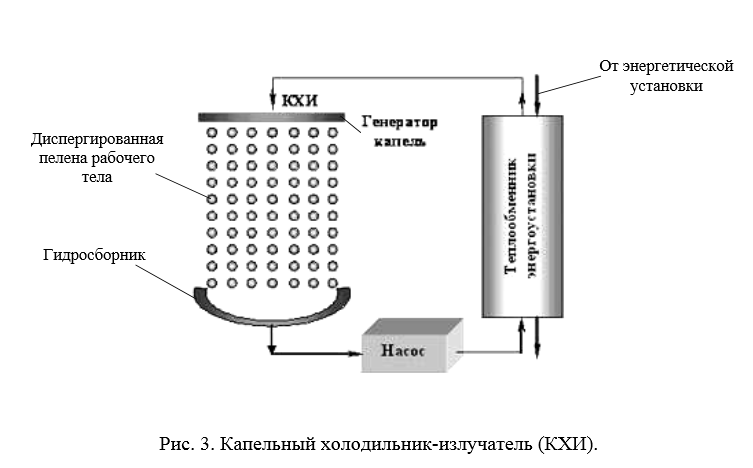
Drip cooler promises a reduction in mass of the radiator at times:

In space (at the Mir and MKS stations), the following drip cooler models were tested:
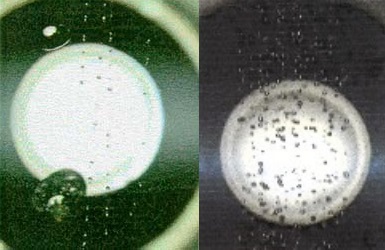
The main intrigue now lies in the speed of development - will they have time to make drip refrigerators by 2020, when the transport and energy module should fly.
Conclusion
In astronautics, the use of nuclear reactors will give us the level of energy unattainable by solar cells. And the combination of an atomic energy reactor with electro-jet engines promises a new level of space exploration.
Used sources and additional materials
In addition to Wikipedia used:
- "Designs of power installations of space vehicles" , educational and methodical complex
- "Works on the drip-emitter cooler" , the site of the research center named. Keldysh.
- “History of Russian Space Nuclear Installations” , site “Made by Us”.
- Materials for drip refrigerators: one , two .
Source: https://habr.com/ru/post/229625/
All Articles